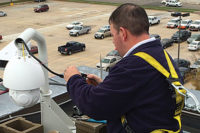The sky's the limit and there's also no boundary to the ingenuity of systems integrators. This article presents three examples of “success stories†in video transmission, which tested the challenges and rigors of their applications.

Harsh Environment No Problem for UTP
The folks at integration company Trans-Alarm Inc., Burnsville, Minn., knew they had a tough installation on their hands when they undertook a recent video transmission specification – but a little ingenuity got the job done.The customer, Chart Industries of New Prague, Minn., southwest of Minneapolis, had quite a demanding environment. The massive manufacturing facility was subject to noise and other conditions, such as high-frequency TIG welding that normally might wreak havoc with traditional video systems transmitted via coaxial cable. The facility includes five buildings and some 250,000 sq. ft. on a 27-acre site, says John Stevens, project manager and sales consultant for Trans-Alarm. Some of the buildings are quite massive in order for manufacturing to take place comfortably, and there is some distance between buildings.
Primarily, the customer wanted to be able to watch key areas of the facility, and 12 cameras were installed, some in enclosures and other full-body units. All cameras feed back to the digital video recorder. Initially installed as part of a full-site security upgrade (including doors and locks, site perimeter fencing, photo identification badges and video security) in the wake of heightened security concerns following the Sept. 11 terrorist attacks, the system is proving useful as a security and facility management tool. In specifying the system, Trans-Alarm wanted to provide an integrated approach that would yield other payoffs to the client, including streamlined information and facility management.
The beauty of the installation lies in the use of existing voice-data wiring, Stevens says. Trans-Alarm technicians ran Category 5 cabling from cameras to the company's existing phone/PBX system in each building. Working with Chart Industries' IT department, they spliced into the existing Category 3 wiring for the continuation of the video system run. They spliced from building to building and the wire runs averaged about 50 to 60 ft., but some of the furthest cameras were as much as 3,000 ft. away. The video signal is not compressed, Stevens says. The system can be set to record at different speeds and resulting frames per second, and recording is done on motion, which “saves hard drive space,†Stevens says.
Cameras are 1/3-in. CCD color units and incidents or exceptions may be viewed by the facility manager at his office via a CCTV monitor or on his personal computer. Other cameras are planned for the facility.

Retrofit Application Fits Video to a “Tâ€
It might have been a specifier's nightmare – an aging surveillance system in a super-fortified structure which required upgrading – but Mike Marshall, sales manager at Cpak in LaGrange, Ga., took it all in stride and followed through on his company's focus as a “technical solutions provider.â€Adding to the challenge of the installation was the facility itself. The Troup County Jail, also in LaGrange, is a secured premises where it would have been difficult to run coaxial cable. In addition, Sheriff Donny Turner had grown tired of recording to videocassette and wanted to upgrade to newer digital video recording and storage technology. Security staff wanted instant access to images and other evidence video provides.
“One of the biggest problems in any penal institution is the nature of the security in the facility. The security is strong, and it is nearly impossible to run cabling through these structures. The customer has to keep disruptions such as running wire, to a minimum,†Marshall says. Marshall opted to use – as he has in the past – a form of unshielded twisted pair technology to transmit video signals.
The way Cpak specified the job is to run Category 5E (enhanced) cabling, used for Ethernet and data communications. In this way, Marshall says “one cable can do the job, and running less cable streamlines the job extensively and greatly reduces installation costs.†In addition, Marshall says the Category 5E cabling affords greater distance and good integrity for video signals, although in this application camera runs were each about 700 to 1,000 ft.
The 32-camera system, which is both outdoors and inside the Troup County Jail, records to a state-of the art digital video recorder, which is actually a server and software which runs on the Windows 2000 Operating System. Live or stored images may be viewed remotely from the existing network and users can move images to any PC on it, as well. Images can also be viewed securely over the Internet using a high-speed connection. Stored images from the video can be reproduced as Mpeg or Jpeg or stored. Typically 30 to 45 days of video are stored, but that is limited only by the size of the hard drive that the customer selects.

State-of-the-Art System Calls for Fiber
When your customer is one of the largest jail facilities in the country, you know you'd better be prepared to find solutions to whatever specifications might come your way.The Pinellas County Jail in Largo, Fla., near Tampa, was an early deployer of a fiber optic system used to transmit video signals. In 1997, Pinellas implemented a massive, state-of-the-art Inmate Video Visitation System, manufactured by VUGate of San Antonio, Texas.
Michael Bulriss, vice president and general manager of VUGate, which also provides installation and maintenance services to Pinellas and other correctional facilities, says the company has used fiber for just about every video application possible, especially prisons and correctional facilities, and other institutions.
With the video visitation system, VUGate and Pinellas County technicians installed the backbone of a remote transmission system from a host of inmate locations – literally hundreds – within the main jail facility to a separate civilian reception center.
Because visitors view prisoners at separate video viewing stations, civilians no longer have to travel into the secured site, a risk itself. Inmates who become agitated from a visit, are separated from view of the general civilian population. The system saves literally hundreds of hours of manpower formerly afforded to guards, who would otherwise have to transport inmates, often long distances, to make visits via traditional methods.
At the Pinellas County Jail, the distance the video signal is sent is much greater than would be possible via copper. The system provides full-motion, non-compressed video: “The picture and exchange between visitors is as lifelike as it could possibly be and there is no lag time in the transmission because of fiber implementation,†Bulriss says.
The ability to send the signal great distances and the lack of compression also attracted the end-user to the product. Currently there are some 150 stations or video phone booths scattered throughout the main jail facility and 54 seats in the visitor center, but the facility continues to expand its use of the technology by adding stations. Currently, the visitor center processes more than 55,000 inmate visitors each year.
The installation distances required fiber links to be run from every individual inmate station to the VUGate Video PBX control system in the remote visitor center. The 54 visitor seats are directly connected to the video PBX via copper. At each inmate station, there's a small camera, viewing monitor, handset and transmission device/transceiver to connect to the fiber.
Copper was simply not practical for the 3,100-bed facility, Bulriss adds. “Due to the distances involved, copper couldn't be used. Fiber preserves the pristine quality of the transmission of the video signal.â€

